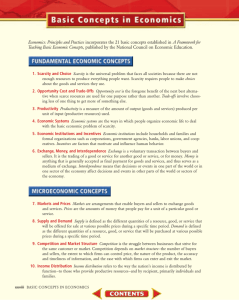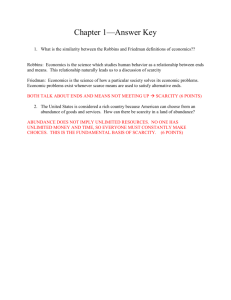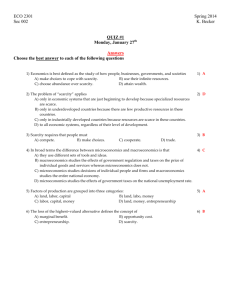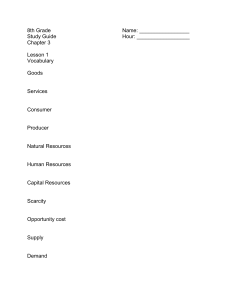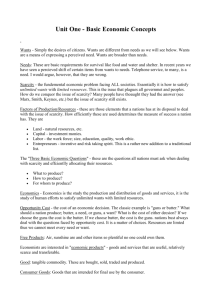Relative scarcity and relative prices What makes something scarce
advertisement
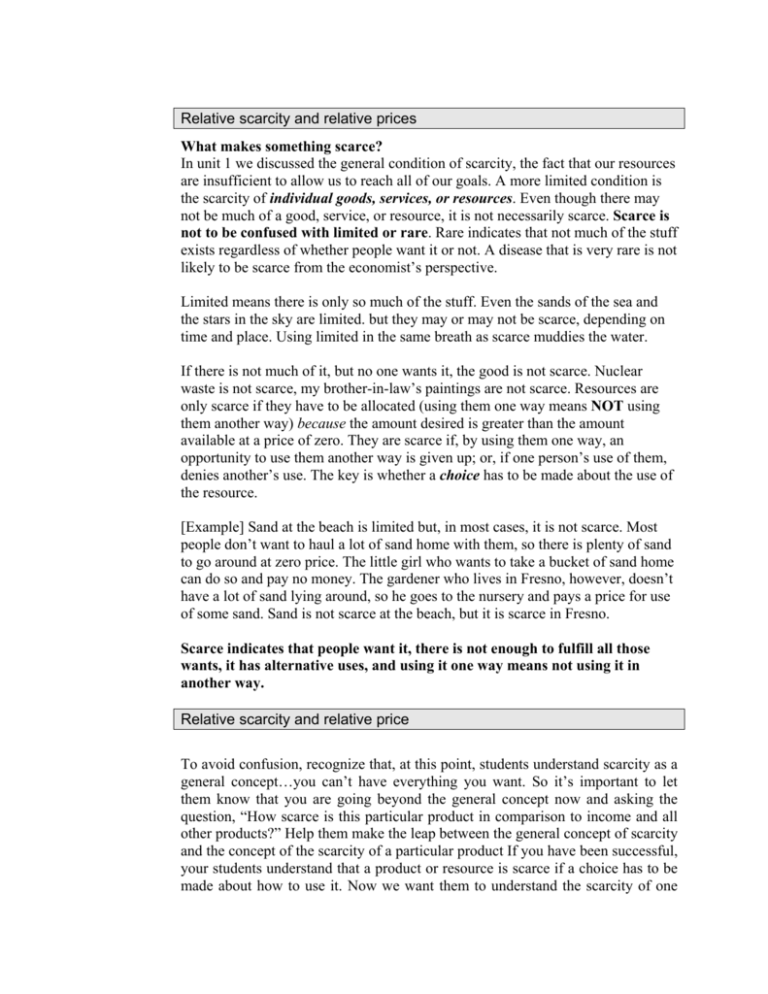
Relative scarcity and relative prices What makes something scarce? In unit 1 we discussed the general condition of scarcity, the fact that our resources are insufficient to allow us to reach all of our goals. A more limited condition is the scarcity of individual goods, services, or resources. Even though there may not be much of a good, service, or resource, it is not necessarily scarce. Scarce is not to be confused with limited or rare. Rare indicates that not much of the stuff exists regardless of whether people want it or not. A disease that is very rare is not likely to be scarce from the economist’s perspective. Limited means there is only so much of the stuff. Even the sands of the sea and the stars in the sky are limited. but they may or may not be scarce, depending on time and place. Using limited in the same breath as scarce muddies the water. If there is not much of it, but no one wants it, the good is not scarce. Nuclear waste is not scarce, my brother-in-law’s paintings are not scarce. Resources are only scarce if they have to be allocated (using them one way means NOT using them another way) because the amount desired is greater than the amount available at a price of zero. They are scarce if, by using them one way, an opportunity to use them another way is given up; or, if one person’s use of them, denies another’s use. The key is whether a choice has to be made about the use of the resource. [Example] Sand at the beach is limited but, in most cases, it is not scarce. Most people don’t want to haul a lot of sand home with them, so there is plenty of sand to go around at zero price. The little girl who wants to take a bucket of sand home can do so and pay no money. The gardener who lives in Fresno, however, doesn’t have a lot of sand lying around, so he goes to the nursery and pays a price for use of some sand. Sand is not scarce at the beach, but it is scarce in Fresno. Scarce indicates that people want it, there is not enough to fulfill all those wants, it has alternative uses, and using it one way means not using it in another way. Relative scarcity and relative price To avoid confusion, recognize that, at this point, students understand scarcity as a general concept…you can’t have everything you want. So it’s important to let them know that you are going beyond the general concept now and asking the question, “How scarce is this particular product in comparison to income and all other products?” Help them make the leap between the general concept of scarcity and the concept of the scarcity of a particular product If you have been successful, your students understand that a product or resource is scarce if a choice has to be made about how to use it. Now we want them to understand the scarcity of one product relative to all others. So, we will try to help them ask and answer the question, “Well how scarce is this product compared to other products?” “Which is scarcer, a pencil or a huge diamond?” “How do we know how scarce one product or resource is compared to all others?” When the word “price” is used in economics, the inference is that the price under discussion is the price of a product relative to all other products. In studying economic history, it is often frustrating when authors state the price of a product such as cinnamon or silk in ancient currencies and weights. For example, in 1284, a pound of mace cost 4s 7d. That statement, by itself, is of no help whatsoever. If a further statement is added, “This sum could also buy three sheep,” we have a little more information. But the final piece of information that would help make sense out of the original statement would be the income of a peasant in 1284. The point is that the first statement provides no information unless the reader knows the prices of other goods and services and the typical income of the consumer. 4s 7d must be put in perspective. The scarcity of a product is determined by the relationship of supply and demand and it is measured by price. But that doesn’t provide much information. Suppose that I told you that the price of a new full sized fully operational car is $1250. You are likely to ask, “Where can I buy it?” and I would have to tell you that you can buy it in 1950 and your salary is $2,900 per year. Take a look at the table below which shows nominal incomes, and prices of different products in 1950 and 1958. 1950 Average annual salary Minimum Wage per hour $2,900 40 cents Car House Gas per gallon Bread per loaf Milk per gallon Postage Stamp $1,250 $10,000 21 cents 9 cents 62 cents 3 cents Rel Scarcity % of income 1958 Rel Scarcity % of income 2 1 4 5 3 6 40% 327% $5,500 $1.00 2 1 4 5 3 6 43% 345% $2,200 $18,000 30 cents 19 cents $1.01 4 cents 1 The first thing to notice is that both cars and houses went down relative to income from 1950 to 1958. In 1950, the price of a car was 43% of average income; in 1958 it was only 40%. In 1950, the price of a house was 3.45 times average income; in 1958 it was only 3.27 times average income. The next thing to notice is that the relative scarcity of the items did not change; the scarcest was still the house, followed by the car, and the least scarce was still the postage stamp. So now you know something about relative prices in 1950 and 1958. Had you been told that the price of a house in 1950 was $10,000, you would have thought, “Gee, 1 The History of Television: The First 75 Years http://www.tvhistory.tv/1945%20QF.htm Unit 9: Buyers and Sellers Determine Prices 2 that is cheap!” But looking at that price as a percent of income from 1950 to 1958, you know that it was actually pretty expensive. The same is true of the statement that the price of a CD is $17. In 2013, $17 is about twice the price of a paperback book and about ½ the price of a sweater and the average income of a worker is about $40,000 per year. If the price of the CD falls, and nothing else changes, buyers will buy more CDs. If however, the price of a CD doubles, at the same time that the price of all other goods and services and all incomes double, there is no incentive to change the amount of CDs purchased. Only if the relative price of CDs changes, is there a change in the incentives of CD buyers and sellers. Ask your students to discuss supply relative to demand in the following examples. The air is electric as people file into the crowded room. A newly discovered Van Gogh is up for auction and art dealers from all over the world have come to bid. Rumors of the discovery have been circulating for months, but most readers figure they are false and that the painting is a hoax. But here it is, validated by the finest art experts in the world, displayed on the podium, closely watched by two not so disguised security guards. What will it go for? Who will get it? The art world is abuzz with speculation. The bidding starts at $2 million but quickly rises to $12 million. The final sale price is $15 million. A young man goes into a hobby shop and wants to buy a famous baseball player’s rookie year baseball card. Two years ago he bought one for $20. The price today is $50. A student decides it is time to buy a new laptop. She goes to the electronics store to find that she can buy a laptop with more memory, greater speed, and many more accessories than she would have dreamed of two years ago. And the price is lower than when she looked a year ago. It is not the supply alone or the demand alone that determines relative scarcity; it is the interaction of sellers (supply) and buyers (demand). As mentioned above, if a thing is rare (low supply), that does not necessarily make it scarce; a rare tropical disease is not scarce. A rare tropical fish, on the other hand, might be very scarce and command a high price if lots of people want it and are willing to pay for it. Rare describes how much is available, scarce describes how much people are willing and able to supply it compared to how much people want it and are willing to pay for it. Relative scarcity depends upon both sellers (supply) and buyers (demand). Even though every human being must have water to survive, it is not very scarce because there is lots of it. In the Sixties, people were buying “pet rocks.” They were ordinary rocks, cleaned, placed in a box, given a name, and sold. (Yes, people actually bought them!) Even though there are not many pet rocks around today, they are not scarce. The reason is not that there aren’t many, the reason Unit 9: Buyers and Sellers Determine Prices 3 they are not scarce is because there is no demand for them. The fact that they were relatively scarce at one time dramatizes the role of demand in the equation. The fact that there is a lot of a product or a little of a product does not, by itself, determine relative scarcity. The fact that lots of people want a product or only a few people want a product does not, by itself, determine relative scarcity. The prices of baseball cards, art, and old stamps and coins illustrate the determination of relative scarcity by supply and demand. Relative price is the measure of relative scarcity. Price is not fair or unfair. As we will see in Unit 10, a price change is caused be a change in either supply or demand, and those changes have nothing to do with fair or unfair. When a teenager’s shoe size goes from 9 to 12 in six months, very few would declaim the fact as being unreasonable, unfair, ridiculous, or a ripoff. When asked how tall she is, a woman might reply that she is 5”6’ and no one would rail against the fact, claiming that a plot had been hatched. If a recipe calls for two cups of flour, very few would claim that the recipe is a plot by the international flour conspiracy. If a worker lives 30 miles from home, people don’t usually picket the office, claiming that the distance is part of management’s plan to exploit the workers. If the temperature rises above 100 degrees, people may complain, but they are not likely to ask Congress to investigate the air conditioning industry. All of the questions above can be answered by a unit of measurement, shoe size, feet and inches, cups, miles, degrees Fahrenheit. And yet that is often the reaction to price changes or prices that people don’t like. A price (in our case in dollars and cents) is the unit which measures relative scarcity. Neither shoe size, nor height, nor weight, nor temperature, nor price are moral measures. Price is not a measure of “worth”. A diamond is merely a shiny rock. While it has some commercial value, it is used mainly to adorn people. Insulin is lifesaving; without it, many people would die. And yet ounce for ounce, the price of insulin is far lower than diamonds. That would appear to make little sense. In some sense, insulin is more “useful” than a diamond. But price is not a measure of the usefulness of an item alone. Water is extremely useful, in fact, necessary for survival, but it has a very low price compared to gold. How is this possible? Isn’t insulin worth more than a diamond? Isn’t water of more use than gold? The confusion lies in the loose use of the words “worth” and “value” and the assumption that they are the same as price. Unlike “worth” or “value,” price is not a measure of the moral or social value of a product; it is the measure of relative scarcity. Price provides a good deal of information about products. Ask your students to rank the following items in terms of relative scarcity. yacht candy bar Unit 9: Buyers and Sellers Determine Prices 4 laptop computer mini truck nice dinner for two in San Francisco Without any information about supply or demand, they would probably rank the yacht as most scarce, followed by the mini truck the laptop, the dinner and the candy bar. They were able to rank the items because they had some idea of the relative prices of the items. Relative scarcity does not give an absolute value of scarcity; it lets people know how scarce a particular item is in comparison to how scarce other items are. It is relative! Remember we said that markets can’t function without information. The price of a product sends information to both buyers and sellers that this product is scarcer or less scarce than other products. Prices are extremely helpful to sellers in that they allow them to make decisions about what to produce and how much to produce. Prices are helpful to buyers because they allow them to make a subjective judgment about how much benefit they expect to get from the product, compare that to the price, and decide whether to buy or not to buy What may seem to be “unfair” is the fact that, in certain markets, a few sellers have some control over price. Many people dislike the existence of the Organization of Petroleum Exporting Countries (OPEC) and the fact that they attempt to manipulate supply, but that does not change the fact that the price of a barrel of oil reflects the relative scarcity of the product as determined by supply and demand. Others may rail against advertising agencies and the ways in which they attempt to manipulate demand for particular products, but that doesn’t change the fact that the price of a carton of lemon yogurt reflects the relative scarcity of lemon yogurt. The fact that those with market power (some control over supply or demand) may succeed in manipulating supply and demand does not change the fact that the price of the product reflects the relative scarcity of that product. Main Points: The Law of Demand states that a higher price will cause a decrease in the quantity demanded and a lower price will cause an increase in the quantity demanded. A demand schedule is a relationship between prices and quantities demanded. The Law of Supply states that a higher price will cause an increase in the quantity supplied and a lower price will cause a decrease in the quantity supplied. A supply schedule is a relationship between prices and quantities supplied. Unit 9: Buyers and Sellers Determine Prices 5 Price elasticity of demand is the strength of the buyers’ response to price changes. The determinants of price elasticity of demand are availability of substitutes, percentage of income, and time. Price elasticity of supply is the measure of the strength of seller’s response to a price change The determinants of price elasticity of supply are time, use of easily transferable resources, and divisibility of inputs. Buyers and sellers (demand and supply) determine equilibrium price and quantity exchanged. At the equilibrium price, the number of items that sellers are willing and able to offer for sale equals the number of items that buyers are willing and able to purchase. Relative scarcity is the relationship of supply and demand. Price is the measure of relative scarcity. Learning Hurdles Incorrect Statement Price is unfair, immoral, and ridiculous. Correct Statement Price is nothing more than the unit by which we measure relative scarcity. A price increase is caused by greed. Price is determined by supply and demand. When costs increase, sellers will just pass the increase on to consumers by raising the price. While an increase in cost is likely to cause a price increase, the amount of the price increase depends upon price elasticity of demand. Sellers must always beware of negative buyer response to price increases. Sellers are constrained by demand. Sellers can charge any price they want. Multiple Choice Questions 1. According to the law of demand, a price increase will cause a(n): a. increase in supply b. decrease in supply c. increase in quantity demanded d. *decrease in quantity demanded 2. Which of the following illustrates a relationship between a set of prices and quantities demanded? a. a supply schedule b. *a demand schedule c. a change in quantity demanded Unit 9: Buyers and Sellers Determine Prices 6 d. a change in quantity supplied 3. According to the Law of Supply, a price decrease will cause a(n): a. increase in supply b. decrease in supply c. increase in quantity supplied d. *decrease in quantity supplied 4. Which of the following illustrates a relationship between a set of prices and quantities supplied? a. *a supply schedule b. a demand schedule c. a change in quantity demanded d. a change in quantity supplied 5. Which of these products is likely to have the greatest price elasticity of demand? a. salt b. pepper c. a particular medicine that has no substitutes d. *a particular brand of gasoline 6. Price elasticity of supply for a particular product is likely to be greater if: a. the time period is short b. the resources used are specific to the product c. *the resources used are easily divisible d. the product lasts a long time 7. Who determines the price of a product? a. buyers b. sellers c. *buyers and sellers d. neither buyers nor sellers 8. Relative scarcity is: a. the same as relative rareness. b. determined by how much of the product exists. c. a measure of the worth of a product to society. d. *the relationship between supply and demand. 9. Relative scarcity is measured by: a. the supply of the product. b. the moral value of the product. c. *the relative price of the product. d. the demand for the product. Unit 9: Buyers and Sellers Determine Prices 7


